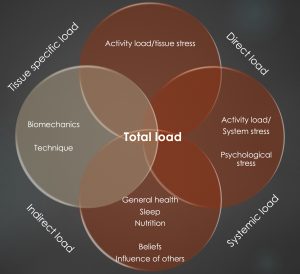In the last post we discussed the impact of direct tissue specific load on back pain. In this post we discuss indirect tissue-specific load, which basically refers to biomechanics, technique and equipment.
BIOMECHANICS
In this context, we use the term biomechanics to describe the movements at joints and the force produced by muscles around the injured area. If we use the example of a fighter who experiences pain with large volumes of punching, we can break down the biomechanics of that technique to ascertain what may be increasing stress on the lower back. When we perform a punch, we need to generate high degrees of rapid rotational force, and this rotation occurs throughout multiple areas of the body. If we are lacking range of motion in important areas such as our hip rotation and upper back rotation then increased rotational demand may be placed on the back. A physical assessment can help determine if such limitations exist, and guide the formulation of a specific program to address these factors.
Using the same example, if a fighter lacks sufficient strength and power through the hip of the back leg, eccentric braking ability on the lead leg, or rotational strength and control through the core, these can all have the potential to influence the load through the lower back, and can be addressed with specific training modalities.
TECHNIQUE
When it comes to technique, fighters may have seemingly poor technique but go through the careers without injury. It is more when we see injury arise after a recent change in technique that we may want to address this, and this is where strong communication between health practitioner, skills coach and S&C staff is vital.
EQUIPMENT
The final aspect to consider here is equipment. This can include gloves, protectors, bags, mitts, training surface etc. If a fighter developed pain after moving to a different gym with a stickier flooring which prevented their normal twisting mechanics, and this was the only major change to their training environment, we may want to look closer at this as a possible contributing factor.
